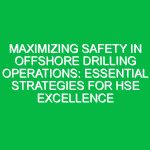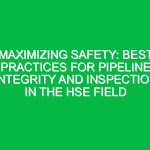In the realm of Health Safety and Environment (HSE), ensuring workplace safety is paramount, especially in industries where pressure systems are a staple. Pressure testing, a critical procedure used to ensure the integrity of these systems, is not without its risks. This comprehensive guide delves into the essential pressure testing safety procedures, offering insights and tips to maintain a safe working environment. By adhering to these guidelines, businesses can mitigate risks, protect employees, and comply with regulatory standards.
Understanding Pressure Testing
Pressure testing, also known as hydrostatic or pneumatic testing, involves subjecting a system to higher than operational pressures to verify its strength and leak tightness. This process is crucial in various industries, including oil and gas, plumbing, and HVAC. Despite its importance, pressure testing poses significant safety risks, making adherence to safety procedures non-negotiable.
Key Safety Procedures for Pressure Testing
Ensuring the safety of workers during pressure testing involves a series of steps, from pre-test planning to post-test evaluations. Here’s what you need to know:
Pre-Test Planning
Effective safety measures start with thorough planning. This includes:
- Risk Assessment: Identifying potential hazards and implementing measures to mitigate them is the first step in ensuring safety.
- Test Procedure Documentation: Clearly document the testing procedure, including the test medium, pressure levels, and duration.
- Equipment Inspection: Inspect all equipment for defects or wear and tear that could compromise safety.
During the Test
Once the test begins, maintaining vigilance is crucial. Key considerations include:
- Monitoring: Continuously monitor pressure levels and system integrity throughout the test.
- Communication: Maintain clear communication among team members to promptly address any issues.
- Emergency Procedures: Ensure all personnel are familiar with emergency shutdown procedures.
Post-Test Procedures
After completing the pressure test, follow these steps to ensure ongoing safety:
- System Depressurization: Carefully depressurize the system, following the documented procedure to avoid sudden pressure drops.
- Inspection and Documentation: Inspect the system for any signs of stress or failure and document the test results.
- Review and Feedback: Review the testing process and gather feedback to improve future tests.
Best Practices for Pressure Testing Safety
Beyond the basic procedures, several best practices can enhance safety during pressure tests:
Use of Proper Personal Protective Equipment (PPE)
Ensure all personnel involved in the test wear appropriate PPE, such as safety glasses, gloves, and ear protection, to mitigate the risk of injury.
Implementing Safety Barriers
Set up physical barriers or designate exclusion zones around the test area to prevent unauthorized access and protect bystanders.
Regular Training and Drills
Conduct regular training sessions and emergency drills to ensure that all team members are prepared to handle potential incidents.
Utilizing Quality Equipment
Only use equipment that meets industry standards and is appropriate for the specific test conditions to ensure reliability and safety.
Common Pitfalls to Avoid
While following safety procedures, it’s also crucial to be aware of common pitfalls that could compromise safety, such as:
- Complacency: Never underestimate the risks associated with pressure testing. Always adhere to safety protocols, regardless of past successes.
- Poor Communication: Miscommunication can lead to errors and accidents. Ensure clear, concise, and constant communication among all team members.
- Inadequate Training: Skimping on training can have dire consequences. Invest in comprehensive training for all personnel involved in pressure testing.
Regulatory Compliance
Adhering to local and international safety standards and regulations is not just about avoiding legal repercussions; it’s about safeguarding lives. Familiarize yourself with relevant HSE guidelines, such as the Occupational Safety and Health Administration (OSHA) in the United States or the Health and Safety Executive (HSE) in the United Kingdom, to ensure compliance and enhance safety.
Conclusion: A Culture of Safety
Ensuring workplace safety during pressure testing is not solely about following procedures; it’s about cultivating a culture of safety where every employee understands the importance of these practices. By implementing the essential pressure testing safety procedures outlined in this guide, conducting regular training, and fostering open communication, businesses can create a safer working environment that protects both their employees and their operations.
Remember, safety is not a one-time effort but a continuous commitment. Stay informed, stay vigilant, and always prioritize the well-being of your team.
Summary of Key Points
- Conduct thorough pre-test planning, including risk assessments and equipment inspections.
- Maintain strict safety protocols during the test, including continuous monitoring and clear communication.
- Follow comprehensive post-test procedures to ensure the system is safely depressurized and inspected.
- Adopt best practices such as using proper PPE, implementing safety barriers, and conducting regular training.
- Avoid common pitfalls like complacency, poor communication, and inadequate training.
- Ensure regulatory compliance to enhance safety and protect lives.
- Cultivate a culture of safety that emphasizes the importance of safety procedures and continuous improvement.
By embracing these essential pressure testing safety procedures, businesses can ensure a safer workplace, protect their employees, and maintain operational integrity.


